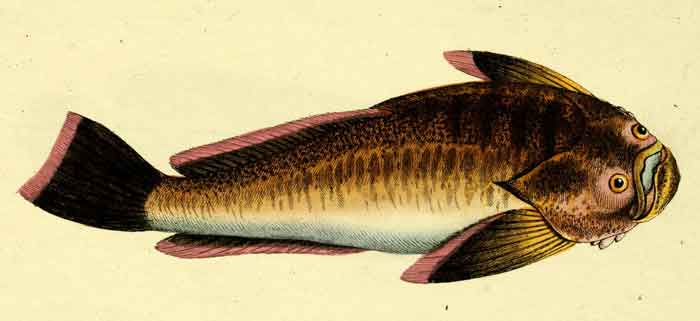Superregnum: Eukaryota
Regnum: Animalia
Subregnum: Eumetazoa
Cladus: Bilateria
Cladus: Nephrozoa
Superphylum: Deuterostomia
Phylum: Chordata
Cladus: Craniata
Subphylum: Vertebrata
Infraphylum: Gnathostomata
Megaclassis: Osteichthyes
Superclassis/Classis: Actinopterygii
Classis/Subclassis: Actinopteri
Subclassis/Infraclassis: Neopterygii
Infraclassis: Teleostei
Megacohors: Osteoglossocephalai
Supercohors: Clupeocephala
Cohors: Euteleosteomorpha
Subcohors: Neoteleostei
Infracohors: Eurypterygia
Sectio: Ctenosquamata
Subsectio: Acanthomorphata
Divisio/Superordo: Acanthopterygii
Subdivisio: Percomorphaceae
Series: Eupercaria
Ordo: Uranoscopiformes
Familia: Uranoscopidae
Genus: Kathetostoma
Species (9): K. albigutta – K. averruncus – K. binigrasella – K. canaster – K. cubana – K. giganteum – K. laeve – K. nigrofasciatum – ?K. fluviatilis
Name
Kathetostoma Günther, 1860: 231
Type species: Uranoscopus laevis Bloch & Schneider, 1801. Type by monotypy.
References
Günther, A. 1860: Catalogue of the acanthopterygian fishes in the collection of the British Museum. 2. Squamipinnes, Cirrhitidae, Triglidae, Trachinidae, Sciaenidae, Polynemidae, Sphyraenidae, Trichiuridae, Scombridae, Carangidae, Xiphiidae. British Museum, London. 2: i-xxi + 1-548.
Gomon, M.F.; Roberts, C.D. 2011: A second New Zealand species of the stargazer genus Kathetostoma (Trachinoidei: Uranoscopidae). Zootaxa, 2776: 1–12. Preview PDF

Kathetostoma laeve
Kathetostoma is a genus of bony fish from the family Uranoscopidae, the stargazers. They are demersal predators which are found in the western Atlantic, Pacific and Indian Oceans, with most species around Australia and New Zealand.
Characteristics
They have a naked body with a head which has a quadrilateral cross section with the eyes directed upward. These have a small, bony orbital rim and are separated by a scaleless rectangular space. The mouth is armed with a number of large canines which sit among smaller canines. The chin is smoothly curved and the lips have short ridge-like crenulations. There are four spines on the ventral margin of preopercle and the anterior end of isthmus has two obvious forward pointing spines. There is a prominent spine on the cleithrum which is sheathed in skin and is located above the base of the pectoral fin base. The lateral line consists of pores in the skin placed high on side near the base of the dorsal fin. The dorsal fin is continuous and has 13–18 segmented rays, the anal fin has 12–18 segmented rays and the pectoral fins are very large and semi-circular while the pelvic fins are moderately large.[3] This is a harmless species to humans and has a flattish head.
Species
The following species are classified within Kathetostoma:[4]
Kathetostoma albigutta (Bean, 1892) - Lancer stargazer
Kathetostoma averruncus Jordan & Bollman, 1890 - Smooth stargazer,
Kathetostoma binigrasella Gomon & Roberts, 2011 - Banded stargazer
Kathetostoma canaster Gomon & Last, 1987
Kathetostoma cubana Barbour, 1941 Spiny stargazer,
Kathetostoma fluviatilis Hutton, 1872 River stargazer
Kathetostoma giganteum Haast, 1873 Giant stargazer
Kathetostoma laeve (Bloch & Schneider, 1801) Common stargazer,
Kathetostoma nigrofasciatum Waite & McCulloch, 1915 Deepwater stargazer,
References
fishbase.de/summery/12920
Bailly N, ed. (2014). "Kathetostoma Günther, 1860". FishBase. World Register of Marine Species. Retrieved 22 June 2018.
Eschmeyer, William N.; Fricke, Ron & van der Laan, Richard (eds.). "Species in the genus Kathetostoma". Catalog of Fishes. California Academy of Sciences. Retrieved 22 June 2018.
Dianne J. Bray. "Kathetostoma". Fishes of Australia. Museums Victoria. Retrieved 22 June 2018.
Froese, Rainer and Pauly, Daniel, eds. (2018). Species of Xenocephalus in FishBase. February 2018 version.
Retrieved from "http://en.wikipedia.org/"
All text is available under the terms of the GNU Free Documentation License

